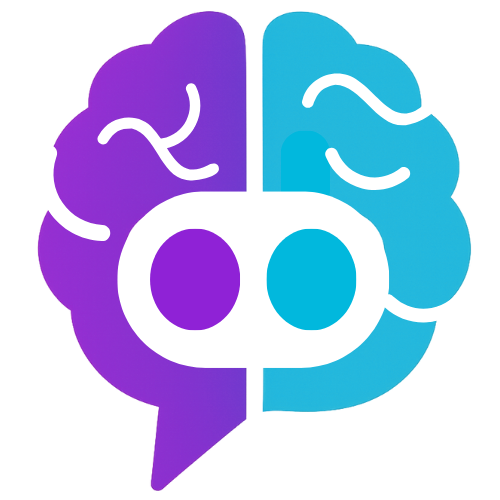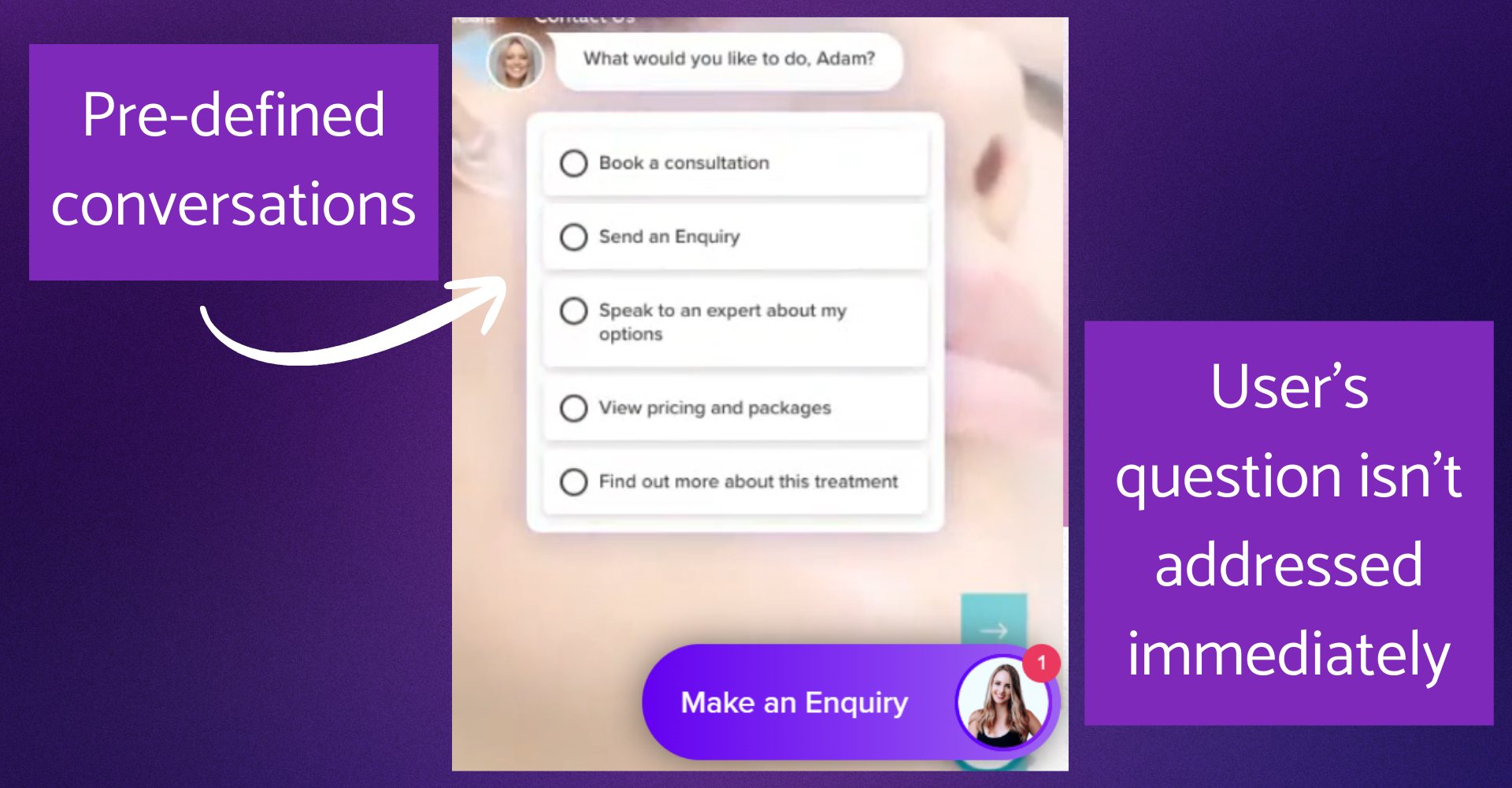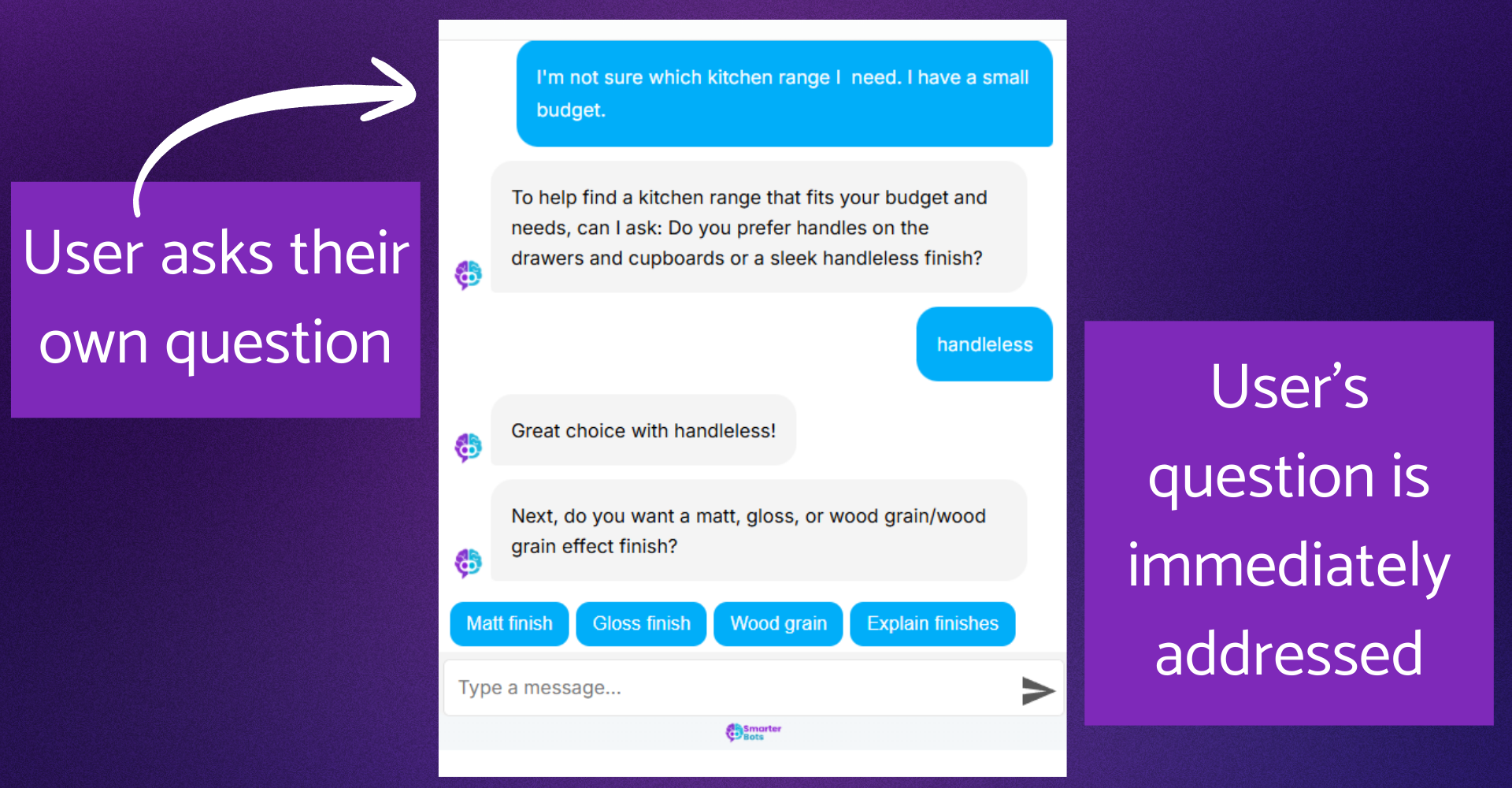Flow Chatbots vs AI Chatbots – Which is Right for Your Business?
We’ve all been there. You land on a website, only to be greeted by a chatbot that feels more like a bad game of twenty questions. You click through a set of buttons, follow a rigid script, and after five minutes you still haven’t got the answer you came for. Frustrating, isn’t it?
That’s the problem with flow chatbots — while they can be handy for very simple, scripted interactions, as soon as a customer steps outside the script, the conversation grinds to a halt.
The good news is that chatbots have evolved. AI-powered chatbots are changing the way businesses interact with customers, offering natural conversations, personalised support, and even sales assistance. In this article, we’ll break down the difference between flow chatbots and AI chatbots, why the old approach is holding businesses back, and how to choose the right solution for your website.
What is a flow chatbot?
A flow chatbot (sometimes called a rule-based chatbot) follows a set of pre-designed paths, often in the form of decision trees. Customers are presented with options such as “Choose A, B or C,” and the chatbot responds based on that choice.
They’re useful for tightly defined, repeatable tasks — for example, directing people to your opening hours or triggering an automated follow-up campaign. But for businesses that want natural, flexible conversations, they often create more friction than they remove.
They’re a bit like automated phone menus: “Press 1 for Sales, Press 2 for Support.”

SmarterBots AI ChatBots
What is an AI chatbot?
An AI chatbot uses artificial intelligence and natural language processing (NLP) to understand and respond to customers in their own words. Instead of forcing people through a pre-set script, it listens to the intent behind the question and delivers a tailored answer.
Unlike flow chatbots, AI-powered bots don’t just rely on buttons or rigid paths. They can:
-
Understand free text questions – customers can type naturally, just like they would to a real person.
-
Pull answers from your business content – trained on your website, FAQs, or documents, the chatbot gives responses that are specific to your business.
-
Learn and improve over time – by analysing conversations, it identifies gaps in your content and helps you spot where customers are getting stuck.
-
Switch between languages – handling conversations in whichever language your customer prefers.
-
Know when to hand over – if a question needs a human touch, an AI chatbot can escalate smoothly instead of hitting a dead end.
Think of it this way: a flow chatbot is like a vending machine with fixed buttons. An AI chatbot is like a skilled shop assistant who listens, understands, and helps you find exactly what you need.
They’re like a skilled shop assistant who listens, understands, and helps you find exactly what you need.
Why are flow chatbots so frustrating?
For campaign-style automations or simple FAQs, flow chatbots can do the job well. But when customers need flexibility and real answers, the experience quickly turns into frustration.
On paper, flow chatbots sound simple enough. They guide customers down a path, narrowing options until they (hopefully) reach the right answer. In reality, though, they often create more friction than they remove.

Here’s why:
-
Rigid scripts – if the customer asks something outside the flow, the chatbot can’t handle it.
-
Too many clicks – customers don’t want to play “choose your own adventure” just to find out your delivery times.
-
Dead ends – flow chatbots often loop back or give up with a generic “I don’t understand,” leaving the user frustrated.
-
Wasted opportunities – when people drop off mid-conversation, you lose potential leads and sales.
It’s no surprise that many customers abandon flow bots altogether. Instead of feeling supported, they feel like they’ve been trapped in a digital maze.
Flow Chatbot vs AI Chatbot — Which is Better for Business?
Both flow chatbots and AI chatbots have their place. But if your goal is to create a smooth customer experience, capture more leads, and actually improve your website performance, there’s a clear winner.
Here’s how they stack up:
| Feature | Flow Chatbot | AI Chatbot (SmarterBots) |
|---|---|---|
| Customer experience | Scripted, click-through, often frustrating | Natural, conversational, responds in real language |
| Flexibility | Limited to pre-set options | Can handle open questions in any order |
| Accuracy | Only answers what’s been pre-programmed | Trained on your website, FAQs, and business docs |
| Suggested Q&As | Mandatory — customers must click | Optional — shortcuts provided when helpful, but free text always works |
| Handling complex queries | Struggles, often hits dead ends | Understands intent, hands over to a human when needed |
| Insights | No analysis of user behaviour | Analyses conversations to spot content gaps and drop-off points |
| Integration | Usually standalone | Connects with CRM to check orders, suggest upsells, recommend services |
| Languages | Single language only | Multi-lingual by design |
The difference is clear: flow chatbots talk at your customers, while AI chatbots like SmarterBots talk with them.
Can AI & flow chatbots integrate with my CRM?
Some flow chatbots can connect to third-party tools like Zapier to pass information between systems. But the process is rigid — the customer has to follow the pre-set path for the integration to trigger, and the bot has no real understanding of what’s happening.
AI chatbots work differently. Because they understand the intent behind the customer’s message, they can access your CRM more naturally. That means they can check an order status, suggest an upsell, or recommend the right service without the user being forced down a narrow script. Instead of just passing data along, AI chatbots actively support your sales process.
Can AI & flow chatbots handle multiple languages?
Flow chatbots are usually written in one language at a time. Some platforms offer multi-language support, but it often requires building separate flows for each language, which quickly becomes unmanageable.
AI chatbots are multi-lingual by design. They can detect and respond in the customer’s language without you needing to build duplicate scripts, making them much more practical for diverse audiences.
Can AI & flow chatbots suggest answers to customers?
Flow chatbots rely heavily on suggested options — customers must click through them to move forward. While this can work for very simple queries, it’s restrictive and frustrating if the answer isn’t on the menu.
AI chatbots give the best of both worlds. They can display optional suggested Q&As as handy shortcuts for common queries, but customers can also type naturally in their own words. This means convenience for those who want quick clicks, without trapping everyone in a rigid flow.

Want to see the difference in action?
Can AI & Flow chatbots hand over to a human agent?
Many flow chatbots allow handover to a live chat agent, but it usually only works if you’ve built a handoff point into the script. If the customer goes off-flow or asks something unexpected, the bot often ends in “I don’t understand” territory.
AI chatbots are human-aware. They can recognise when a query requires a real person and escalate smoothly, even if the customer hasn’t followed a pre-set path. This keeps conversations flowing instead of ending in frustration.
Conclusion: Choosing the Right Chatbot for Your Business
Flow chatbots had their moment, and they still have their place. For example, tools like ManyChat are widely used by influencers to run quick campaigns: a viewer types a keyword in the comments, the chatbot instantly replies, captures an email, and triggers a follow-up sequence with vouchers or promotions. For simple, transactional tasks like this, flow bots remain effective.
But when it comes to customer experience on a business website, flow chatbots quickly hit their limits. Customers don’t want to be forced through a rigid script — they want answers in their own words, support that adapts to their needs, and conversations that feel natural.
That’s where AI chatbots shine. They understand intent, handle multiple languages, integrate with your systems, and know when to bring in a human. Most importantly, they move beyond scripted clicks and create experiences that drive real sales and long-term relationships.
So if you’re choosing between the two, ask yourself:
-
Do you need a chatbot for simple one-off automations? Flow might be enough.
-
Do you want a chatbot that can adapt to your customers and grow with your business? AI is the clear choice.
With SmarterBots, you get a chatbot trained on your business, designed to engage, and built to deliver measurable results.



